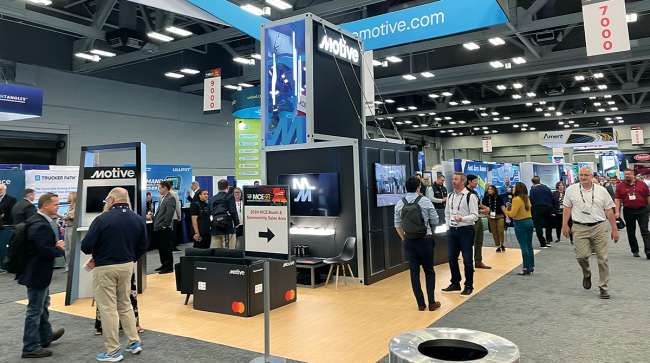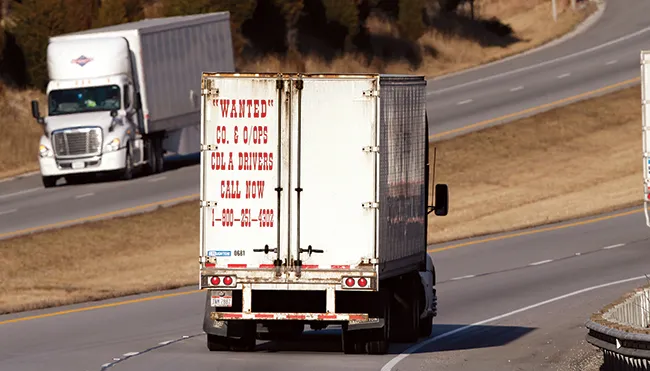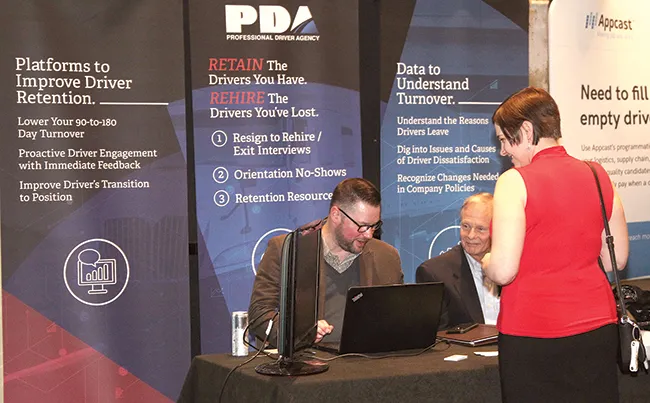Special to Transport Topics
Recruiting and Retaining Drivers Remains a Challenge

[Stay on top of transportation news: Get TTNews in your inbox.]
Managing driver retention is an ongoing challenge for many trucking companies. At family-owned McLeod Express in Decatur, Ill., the company culture is a key selling point. For one thing, to help retain talent, the fleet — which operates through the Eastern and Midwest United States — offers varied route options, such as local transport, shuttle, over-the-road and flatbeds.
However, McLeod driver recruiter Randy Gretz points out that recruitment and retention is as much a challenge in offering enticements as it is with managing driver expectations.
“People need to have a realistic picture with honest expectations when being recruited,” Gretz said. “Companies tell people what their highest paid drivers are making, but that’s not realistic for new drivers, and they need to have honest expectations.”
The economics of recruiting and retaining drivers has taken on a new layer of challenge recently, as a slowing freight market has shaken up the driving ranks. Amid what many have called a freight recession, keeping one’s best drivers takes on a new level of priority, said Scott Dismuke, vice president of operations for the Professional Driver Agency.

Dismuke
“There’s no doubt that investing in recruitment and retention during the slowdown will pay off when freight comes back,” he said. Dismuke noted that his group is seeing companies investing in finding and keeping good drivers, and looking closely at driver satisfaction during this slowdown.
In fact, the Q3 2023 Driver Recruiting and Retention Download that PDA produces in partnership with Conversion Interactive Agency noted that equipment and compensation were top concerns for drivers.
“While some of our Q3 data shows some minor signs of encouragement on the recruiting and retention front, a rise in driver concerns relating to equipment issues and stagnant freight continue to have an impact,” the October report noted. Specific to compensation, more than half of drivers said a lack of miles was the primary reason for their compensation issues. Of those, 66% said the two biggest factors were loads not being available and inconsistent miles.

Although the truck driver shortage is far from resolved, the retention gap has decreased year-over-year. (John Sommers II for Transport Topics)
“The trucking economy is cyclical,” the report said. “This is not the first freight recession, nor will it be the last. What we do know is when freight comes back, it will come back quickly.”
This intersection of the economy and driver issues was on display in October when the American Transportation Research Institute issued its Top Industry Issues list during American Trucking Associations’ annual Management Conference & Exhibition. While the economy claimed the top spot on the list, the driver shortage landed at No. 4 while retention ranked No. 8 on the list. While ATA hasn’t yet calculated its official driver shortage number for 2023, in 2022 it forecast the number would fall to 64,200 from nearly 78,000 last year. The shortage hit a high of 81,000 in 2021.

During the busy pandemic-era freight surge, many fleets increased pay rates and boosted retention bonuses. In June, ATRI in its 2023 Operational Costs of Trucking report noted that the average retention bonus for drivers had reached $1,272, up nearly 90% over the previous four years.
Now, amid a slower market, those enticements may dry up and drivers may be faced with fewer alternatives — making them more likely to stay. Fleet management technology firm Motive Inc. from its Holiday Outlook Report issued in October noted that the number of drivers leaving their jobs declined steadily from Q3 2022 to Q3 2023.
“Industries seeing the largest improvement include passenger transport, retail and warehousing,” the report said. “However, this improvement might be due to carriers leaving the market, and hiring slowing down, limiting drivers’ job choices and making them more likely to stay where they are.”

Johnson
Gary Johnson, the company’s head of safety and compliance strategy, noted companies are in some cases expanding use of technology — including dual-facing dash cameras, which can document and support drivers’ actions in the event of a crash — to improve driver retention. “We’ve seen carriers taking advantage of technology in addressing driver satisfaction to keep drivers,” he said. “People don’t leave because of technology. It opens doors to get in front of issues.”
Johnson described the use of technology as akin to an athlete reviewing game film. “Video has definite advantages of seeing exactly what is occurring with the driver. Old video mentoring was lagging in time with 24 to 72 hours needed for response,” he explained. “Current technology allows video mentoring with almost immediate response.”
Johnson noted that drivers’ privacy and safety will always be a concern, so proactive communication is always needed. “Given what technology has enabled, its role is much higher than it’s ever been,” he said.

PDA’s Scott Dismuke (center) says that investing in recruitment and retention during the freight slowdown will pay off when volumes come back. (John Sommers II for Transport Topics)
The ATRI operational costs report noted that fleets should also evaluate the impact of truck driver benefits, including health insurance and retirement benefits, on driver retention: According to the report, 80% or more of participating motor carriers provided a suite of benefits to their drivers including health insurance (97% of fleet), paid vacation (91%), 401(k) (85%) and dental insurance (81%). In addition, the percentage of fleets providing health, paid vacation and 401(k) increased, an indication that these fleets believe these core benefits are an important component in retaining drivers.
ATRI also recommended that fleets conduct market research on truck driver experiences and perspectives, and said fleet managers must understand “not only how drivers feel about their job but also the differences in those perspectives between new entrant and veteran drivers.”
Want more news? Listen to today's daily briefing below or go here for more info:




